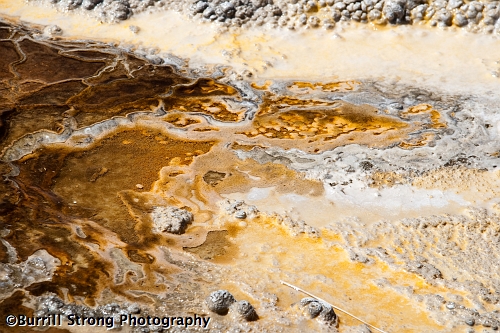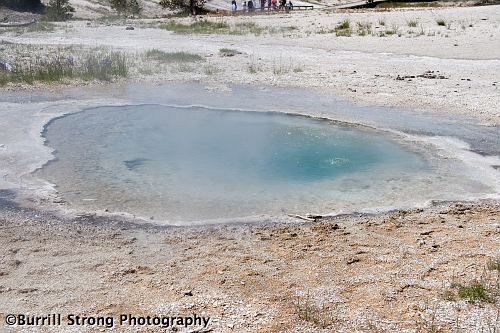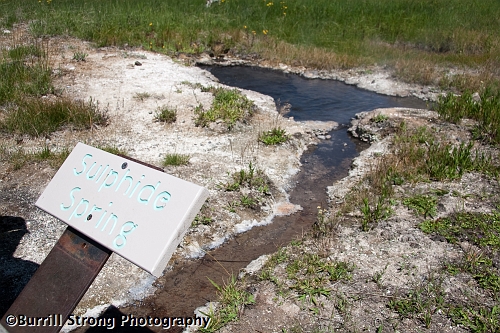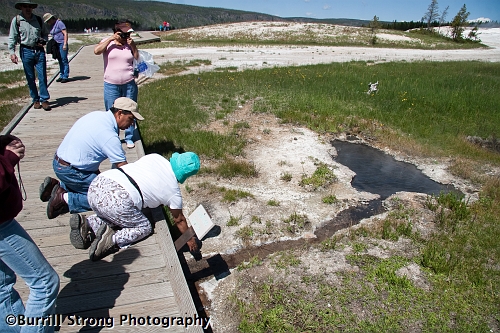Most of Yellowstone bears a generally neutral outdoor smell, but the sulphur in the park’s thermal features provides a more pungent odor for tourists to enjoy in those relatively small areas. And, as anybody who’s lived in a house with well water can attest, the odor isn’t all the sulphur contributes to the park: just as it stains carpets and toilets, it also stains rock. But unlike those generally unpopular carpet and toilet stains, the stains on Yellowstone’s rock are gorgeous.



Of course, those stains need more than just intermittent bursts of water from the most spectacular geyser eruptions to form; the colorful compositions pictured above were caused by the more consistent flow of hot water from a variety of less dramatic holes in the ground.


Sternly-worded warning signs are a frequent and prominent feature throughout the park, and for good reason: for the flocks of tourists who might not know what common sense means outside an urban setting, the unrestrained natural world can be dangerous. This sad truth is newly illustrated each year by careless or foolhardy visitors who venture off the established boardwalks and trails and fall into the park’s thermal features; some escape with severe burns, but others aren’t so fortunate: 20 visitors have died from encounters with the thermal features. If you imagine jumping into a huge pot of boiling water on a huge stove, you have a good idea of what it would be like to fall into one of the park’s thermal features — and, I hope, you have an even better idea of why the warning signs aren’t paranoid suggestions. In many cases, the water actually is visibly boiling.



As we were examining the curious features, one Hispanic visitor — who apparently didn’t think much of the warning signs — felt compelled to see if the water really was as hot as it looked. The water exiting the spring in the above photo ran within arm’s reach as it traveled under the boardwalk, so he knelt down on the boardwalk and reached his hand out toward the water. The moment his finger touched the water, he immediately jerked his hand back and exclaimed, “Muy caliente!”
Before I could muster the necessary amount of disdain to laugh at his obvious lack of common sense, he made another decision that prompted me to put my camera to my eye. After he made sure the tip of his finger was still there, he eagerly gestured to his wife to test the water, just as he had done. A thoroughly sensible woman might have pointed to his reaction as a fine reason not to follow his example; instead, as a relative aimed her camera to record the moment, she knelt down on the boardwalk and reached toward the same scalding water.

To my relief, her arm was a bit shorter than her husband’s, and she wasn’t nearly as committed to the idea as he had been. She posed for a photo as shown above, but she elected not to make the extra effort necessary to reach the water.
(Just a note: though I made an effort to detail some of the park’s dangers, it’s not my intention to make this post an unpleasant representation of the Yellowstone experience. The park is a stunning and highly accessible display of some of earth’s more grandiose and bizarre features, and I believe it’s one of the places everybody should make an effort to visit. But from both the tone of the warning signs and the numerous stories of behavior that ranges from foolhardy to fatal, it’s apparent that far too many visitors aren’t inclined to take seriously the very real dangers of the world outside our controlled civilization. If you are able to make a visit to Yellowstone, see as much as you can and have a great time…but please, pay attention to the warning signs, treat the park’s features with a healthy respect, and exercise intelligent restraint and common sense. Yellowstone isn’t an amusement park; it’s the real world.)

Perhaps the same people who spill hot coffee on themselves and then sue the fast food chain that sold it to them visit Yellowstone.
I just learned all the facts of that this week. She was held 20% responsible but was awarded a sum to cover her medical costs since 185 degree coffee caused major burns.
http://en.wikipedia.org/wiki/Liebeck_v._McDonald%27s_Restaurants
I thought it was interesting.
That IS interesting — thanks for the link! Most interesting to me is that despite that widely-publicized lawsuit, 185 degrees seems to be not just widely accepted but actually the preferred temperature for coffee.
We listened to a CD describing the features of the park as we waited for the bison each day. After hearing stories on the CD of kids falling into the water and dying, our older kids asked at every stop whether this was the place where the kid fell in.